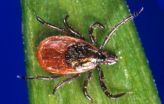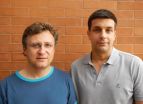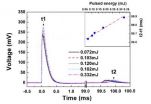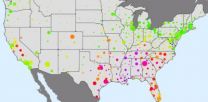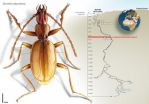(Press-News.org) Engineers at the University of Illinois at Urbana-Champaign demonstrated a class of walking "bio-bots" powered by muscle cells and controlled with electrical pulses, giving researchers unprecedented command over their function. The group published its work in the online early edition of Proceedings of the National Academy of Science.
"Biological actuation driven by cells is a fundamental need for any kind of biological machine you want to build," said study leader Rashid Bashir, Abel Bliss Professor and head of bioengineering at the U. of I. "We're trying to integrate these principles of engineering with biology in a way that can be used to design and develop biological machines and systems for environmental and medical applications. Biology is tremendously powerful, and if we can somehow learn to harness its advantages for useful applications, it could bring about a lot of great things."
Bashir's group has been a pioneer in designing and building bio-bots, less than a centimeter in size, made of flexible 3-D printed hydrogels and living cells. Previously, the group demonstrated bio-bots that "walk" on their own, powered by beating heart cells from rats. However, heart cells constantly contract, denying researchers control over the bot's motion. This makes it difficult to use heart cells to engineer a bio-bot that can be turned on and off, sped up or slowed down.
The new bio-bots are powered by a strip of skeletal muscle cells that can be triggered by an electric pulse. This gives the researchers a simple way to control the bio-bots and opens the possibilities for other forward design principles, so engineers can customize bio-bots for specific applications.
"Skeletal muscles cells are very attractive because you can pace them using external signals," Bashir said. "For example, you would use skeletal muscle when designing a device that you wanted to start functioning when it senses a chemical or when it received a certain signal. To us, it's part of a design toolbox. We want to have different options that could be used by engineers to design these things."
The design is inspired by the muscle-tendon-bone complex found in nature. There is a backbone of 3-D printed hydrogel, strong enough to give the bio-bot structure but flexible enough to bend like a joint. Two posts serve to anchor a strip of muscle to the backbone, like tendons attach muscle to bone, but the posts also act as feet for the bio-bot.
A bot's speed can be controlled by adjusting the frequency of the electric pulses. A higher frequency causes the muscle to contract faster, thus speeding up the bio-bot's progress. Seen a video at https://www.youtube.com/watch?v=skCzl7FlM34.
"It's only natural that we would start from a bio-mimetic design principle, such as the native organization of the musculoskeletal system, as a jumping-off point," said graduate student Caroline Cvetkovic, co-first author of the paper. "This work represents an important first step in the development and control of biological machines that can be stimulated, trained, or programmed to do work. It's exciting to think that this system could eventually evolve into a generation of biological machines that could aid in drug delivery, surgical robotics, 'smart' implants, or mobile environmental analyzers, among countless other applications."
Next, the researchers will work to gain even greater control over the bio-bots' motion, like integrating neurons so the bio-bots can be steered in different directions with light or chemical gradients. On the engineering side, they hope to design a hydrogel backbone that allows the bio-bot to move in different directions based on different signals. Thanks to 3-D printing, engineers can explore different shapes and designs quickly. Bashir and colleagues even plan to integrate a unit into undergraduate lab curriculum so that students can design different kinds of bio-bots.
"The goal of 'building with biology' is not a new one - tissue engineering researchers have been working for many years to reverse engineer native tissue and organs, and this is very promising for medical applications," said graduate student Ritu Raman, co-first author of the paper. "But why stop there? We can go beyond this by using the dynamic abilities of cells to self-organize and respond to environmental cues to forward engineer non-natural biological machines and systems.
"The idea of doing forward engineering with these cell-based structures is very exciting," Bashir said. "Our goal is for these devices to be used as autonomous sensors. We want it to sense a specific chemical and move towards it, then release agents to neutralize the toxin, for example. Being in control of the actuation is a big step forward toward that goal."
INFORMATION:
The National Science Foundation supported this work through a Science and Technology Center (Emergent Behavior of Integrated Cellular Systems) grant, in collaboration with the Massachusetts Institute of Technology, the Georgia Institute of Technology and other partner institutions. Mechanical science and engineering professor Taher Saif was also a co-author. Bashir also is affiliated with the Micro and Nanotechnology Laboratory, the department of electrical and computer engineering and of mechanical science and engineering, Frederick Seitz Materials Research Laboratory and the Institute for Genomic Biology at the U. of I.
Editor's note: To reach Rashid Bashir, call 217-333-1867; email rbashir@illinois.edu.
The paper, "Three-dimensionally printed biological machines powered by skeletal muscle," is available from PNAS or the News Bureau.
Muscle-powered bio-bots walk on command
2014-07-01
ELSE PRESS RELEASES FROM THIS DATE:
Reducing deer populations may reduce risk of Lyme disease
2014-07-01
Since white-tailed deer serve as the primary host for the adult blacklegged tick (Ixodes scapularis) — the vector for Lyme disease — scientists have wondered whether reducing the number of deer in a given area would also mean fewer cases of Lyme disease. Now, after a 13-year study was conducted, researchers in Connecticut have found that reduced deer populations can indeed lead to a reduction in Lyme disease cases. The results of their study are published in the Journal of Medical Entomology .
The researchers surveyed 90% of all permanent residents in a Connecticut ...
Enlightening cancer cells
2014-07-01
This news release is available in German.
Harald Janovjak, Assistant Professor at IST Austria, together with Michael Grusch, Associate Professor at the Institute of Cancer Research of the Medical University of Vienna, "remote-controlled" the behaviour of cancer cells with light, as reported this week in EMBO Journal (DOI: 10.15252/embj.201387695). This work is the first application of the new field of optogenetics to cancer research.
To understand the dynamics of cellular signaling, researchers need to activate and inactivate membrane receptor proteins, which ...
A new method to detect infrared energy using a nanoporous ZnO/n-Si photodetector
2014-07-01
Experiments aimed at devising new types of photodetectors have been triggered by the increasing use of optoelectronic devices in personal electronics, cameras, medical equipment, computers and by the military. Professor Zhao Kun and co-researchers at the State Key Laboratory of Petroleum Resource and Prospecting, part of the China University of Petroleum in Beijing, have proposed a new type of infrared photodetector.
Photodetectors, which can convert photons to electrical signals, are used to observe and measure the wavelength or energy of light, including infrared light, ...
Drink walkers do it because their mates think it's okay: QUT study
2014-07-01
Friends may be the key to stopping their mates drink walking, a risky behaviour that kills on average two Australians every week, a QUT study has found.
Researcher Dr Ioni Lewis, from QUT's Centre for Accident Research & Road Safety - Queensland (CARRS-Q), said in a survey of young people aged 17 to 25, friends were the strongest influence on their intentions to drink walk.
"Drink walking, or walking while intoxicated in a public place, is linked to increased risk of injury and fatality," Dr Lewis said.
In a survey, published in Transportation Research, more than ...
EORTC presents European solution for effective cancer drug development
2014-07-01
Drug developers are facing the perfect storm. They are confronted with major patent expiries, increased payer scrutiny, changing priorities, shifting business models, increased risk averseness, increased clinical trial costs, not to mention issues concerning R&D productivity. There needs to be a better way to identify new candidate drugs. There needs to be a new drug development pathway that is compatible with research aimed at understanding the biology of a cancer and simultaneously able to support the design and conduct of subsequent confirmatory trials, but building ...
Unsuspected aspect of immune regulation revealed
2014-07-01
A discovery by Australian immunologists, uncovering an additional role for antibody-making 'B cells', is considered important enough by the American Association of Immunologists to rank it among the top 10% of articles in the latest issue of The Journal of Immunology, off the press today.
The finding by Senior Research Assistant Stacey Walters and Associate Professor Shane Grey, from Sydney's Garvan Institute of Medical Research, shows that B cells also participate in the development of 'regulatory T cells'.
T cells develop in the thymus gland, a soft triangular organ ...
New analysis of 'swine flu' pandemic conflicts with accepted views on how diseases spread
2014-07-01
The most detailed analysis to date of the spread of the H1N1 2009 pandemic influenza virus, known informally as 'swine flu', has found that short-range travel was likely the primary driver for the 2009 pandemic in the United States, in contrast with popularly accepted views on the way diseases spread.
The study, based on data gathered from health insurance claims made throughout 2009, found that international air travel, which was previously thought to be important in the pandemic, played only a minor role in its spread within the US.
A team of researchers from University ...
Cancer risk: Aspirin and smoking affect aging of genes
2014-07-01
The risk of developing cancer increases with age. Factors like smoking and regular aspirin use also affect the risk of cancer – although in the opposite sense. Researchers from the University of Basel were now able to show that aspirin use and smoking both influence aging processes of the female genome that are connected to colorectal cancer. The Journal of the National Cancer Institute has published their results.
Already in the 1990s, scientists discovered that regular use of aspirin over long periods of time decreases the cancer risk. Since then, numerous studies have ...
Analysis of the Chinese facial profile: Contours of the side face in the Tu & Zang ethnic minorities
2014-07-01
Li Haijun and fellow researchers at Minzu University of China, in Beijing, conducted a series of geometric morphometric analyses of the contours of the side face and variations in the Tu and Zang (Tibetan) ethnic minorities from Qinghai Province, in northwestern China.
Their study, entitled "Morphometric analysis of the Chinese facial profile: Contours of the side face and variations in the Tu and Zang ethnic minorities", was published (in Chinese) in the Chinese Science Bulletin, 2014, Vol 59(16).
The team of researchers used advanced digital cameras and image processing ...
A Spaniard and a Portuguese discover a new species of beetle in the world's deepest cave
2014-07-01
The unusual habitat of the Krubera cave in the Western Caucasus remains a mystery. Researchers from two Spanish universities have discovered a new species of beetle in the depths of this cave.
Cave beetles are one of the most iconic species found in subterranean habitats. They were historically the first living organisms described by science that are adapted to the conditions of hypogean or subterranean life.
Now, a Portuguese scientist and a Spaniard have discovered a new species of beetle in the deepest cave known to man; a cave 2,140 metres deep. It is the Krubera ...

